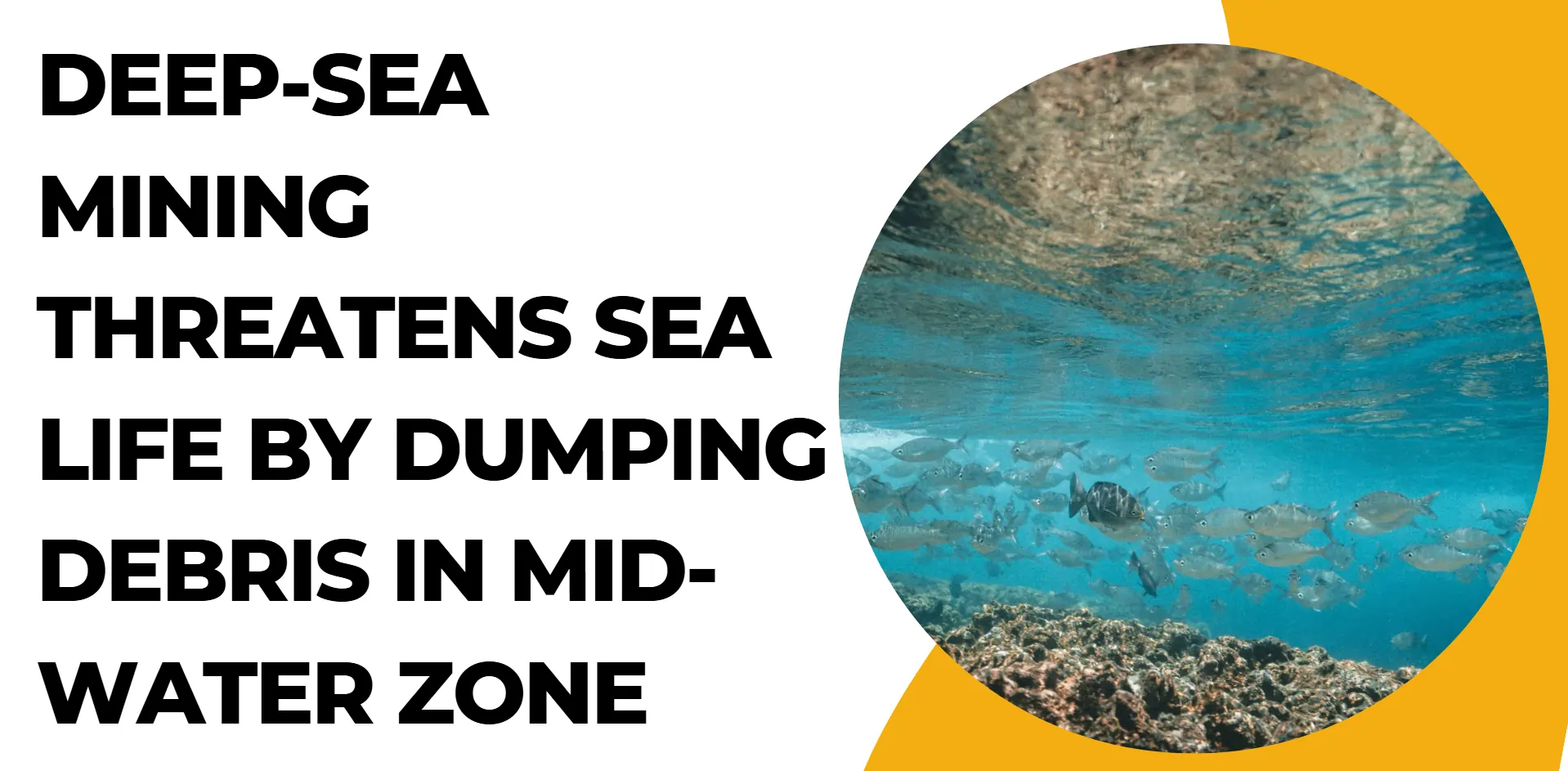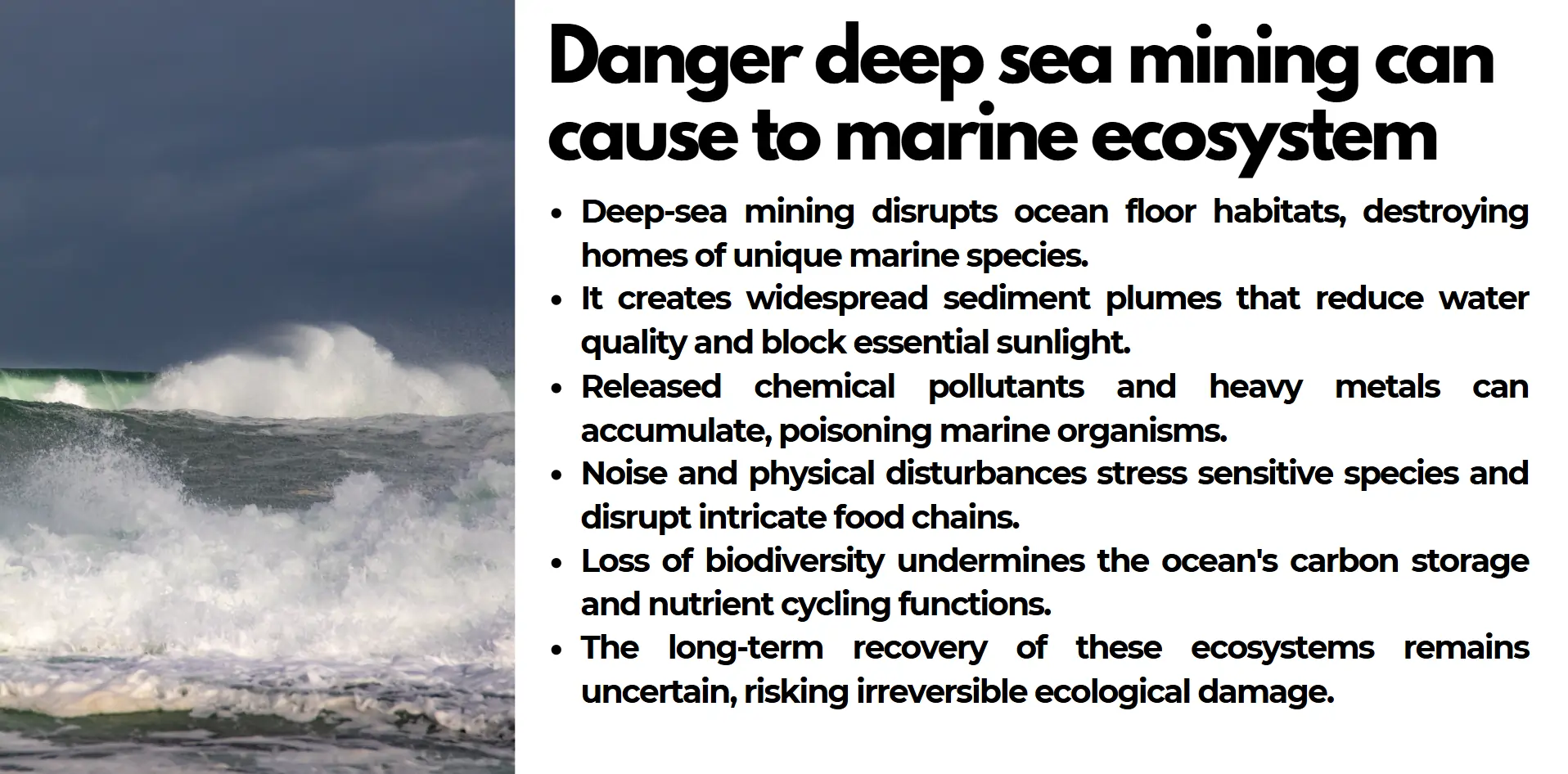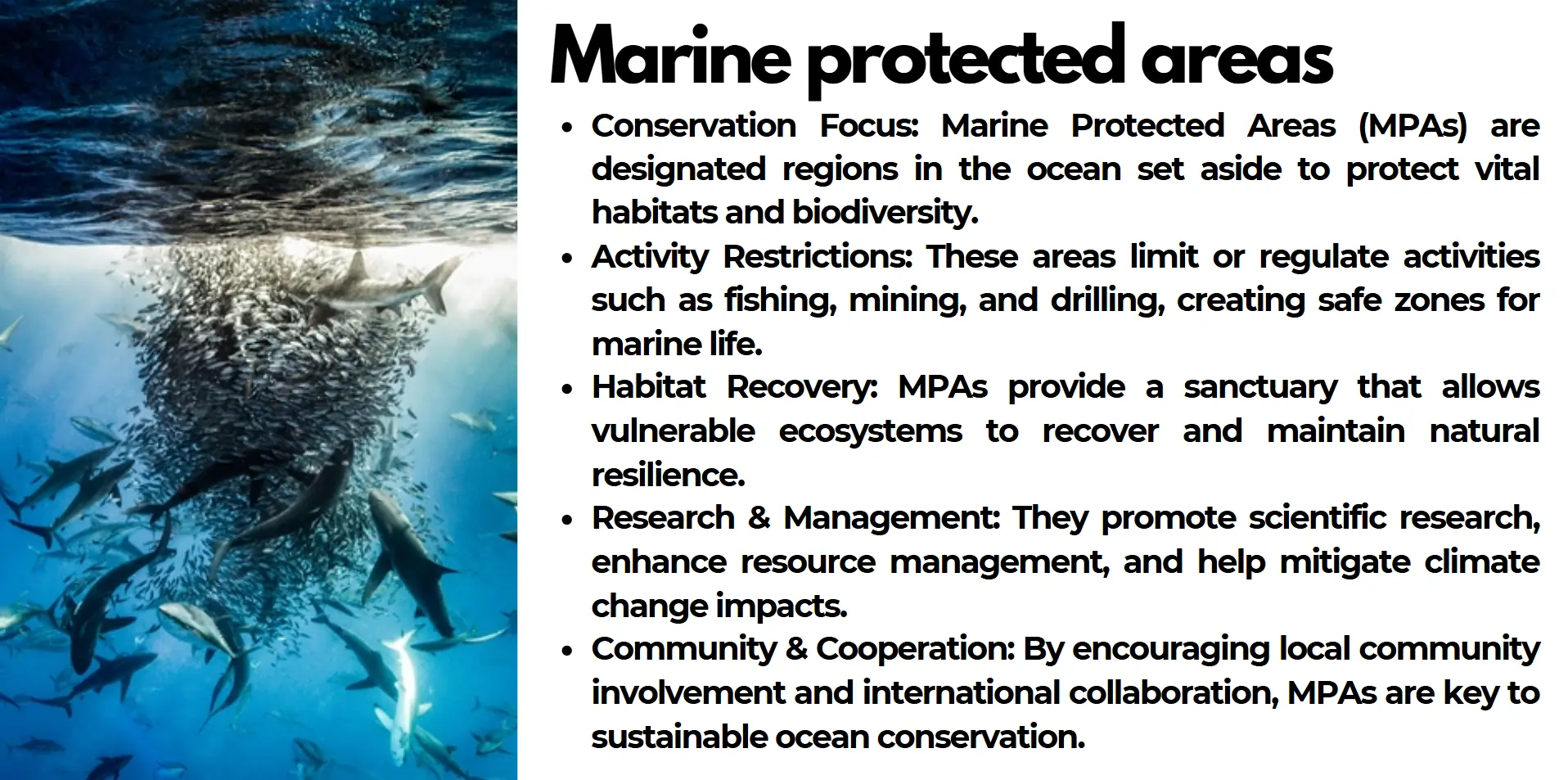By removing resources from the ocean floor, deep-sea mining harms mid-water and marine ecosystems, resulting in sediment plumes, chemical pollutants, and effects on habitat and food.

The main aim of deep-sea mining involves the extraction of resources on the ocean floor but it also causes damage to the marine ecosystem. As the global need for elements such as rare earth metals and other minerals increases, there is usually little consideration on the effects that mining brings on the environment. The worst effect is disposal of wastes in mid water which is a significant layer in the ocean that is inhabited and supports life, and also which helps in recycling nutrients and carbon dioxide. The mid-water zone is threatened by sediment plumes and chemical pollutants that impact food and habitats. This Article aims at discussing the implication of deep-sea mining on the environment especially the mid-water area.
What is Deep-Sea Mining?
Deep-sea mining can be described as the extraction of resources and minerals from a certain depth of the ocean, which is deeper than 200 meters. With the global population expanding and the resource demands rising, conventional mineral deposits on the surface of the earth are depleting fast and deep sea mining is viewed as a solution. Such minerals are used in the manufacturing of battery, renewable energy equipment, and electronics among others which are key in industrial and economic development.
Deep sea mining is a method that involves use of equipment and technology that focuses on the extraction of mineral resources in certain areas of deep sea zone including the manganese nodules that are located at abyssal plains, the hydrothermal vents, and seamounts. Conventionally, distant-controlled tools and tools involving dredge are used to cut, suck or core the ocean bottom surface to obtain the required material for the next process. The scale of these activities, as a rule, depends on the type of deposits and its location, and also on the technological potential.
However, the process of mining at the bottom of the sea has remained widely discussed due to the negative impacts on the environment. On the one hand, supporters stress that it can help obtain necessary funds to support various initiatives that would improve the quality of life in the developing world; on the other hand, the opponents identify potential dangers to some endangered marine species. They include the bottom of the sea, to which the practice results in the formation of sediment plumes which in turn deposit debris in the mid-water habitat of the sea that is crucial to the marine life. Also, it has impacts on the quality of water and the type of living since chemicals and heavy metals are set free in mining.
The practice of deep-sea mining is now becoming popular, but there is not a clear legal regime on the practice. Furthermore, the issues of license control and policy-making for seabed metallic ore mining are attributed to the International Seabed Authority (ISA), which still lacks an effectively enforced and sufficient environmental protection system. A remarkable need for a balance between economic profits and ecological concerns is realised thus requiring sound investigations, policies, and other means of exploitation.
The Mid-water Zone Ecosystem
Mesopelagic zone or mid-water zone is one of the ocean’s intriguing regions that is found between 200 metres and 1000 metres deep in the ocean. Although light in this zone is considerably less penetrating and there is great pressure, it considered as zone in between the epipelagic zone, the zone that receives light from the sun and the aphotic zone, the deep ocean, without any access to sunlight. That may be the reason why the mid-water environment is characterized by high liveliness of various species and its importance for the condition of marine life and interactions.
Another prominent characteristic of the mid-water zone is that the region possesses its own form of exotic life forms. Due to their bioluminescent shrimp, there are fishes including the lanternfish, jellyfish, squid, or the zooplankton that prefer the deep-sea environment with little light. In the deep sea, there are various kinds of organisms which emit light known as bioluminescence in catching their prey or avoiding the predators. This zone also plays an important role for some migratory species and predators as well as a link between food chains of different ocean layers.
The mid-water zone is not only an important habitat for the country’s population of fish and marine mammals but also plays a vital role in other ways. This zone is vital in the cycling of nutrients and afford carbon storage because materiel from the upper part of the water column settles on this layer and can either be grazed or transported to other layers. This actually acts as what scientists call the “biological pump” with the function of balancing the amounts of carbon in the atmosphere.
However, the mid-water zone is experiencing a lot of threats resulting from human activities such as deep sea mining. The mining process including sediment plumes and solid debris have negative impacts on habitats; reduce the availability of food; and introduce toxic materials into the aquatic environments. These interferences are not only affecting this specific zone of the ecological system but also much broader areas of the marine systems.
It is necessary to declare the importance of the mid-water zone as a poll and maintain the oceanic processes, as well as to fight against climate change. It draws upon itself the language of wholeness and the beauty of the earth and also when one looks at it as a clue to environmental conservation.
Impacts of Debris Dumping from Deep-Sea Mining
There are high chances of debris polluting the deep-sea environment when mining of the deep-sea resources is carried out; this has some adverse effects of the mid-water environment and the entire oceanic ecosystem. As much as minerals are exploited from the ocean bottom through mining, sediment plumes as well as wastes result to being released into the water column. These plumes have suspended particles, chemical agents and heavy metal substances with disastrous effects on the marine lives.

The first one is the alteration of habitats, meaning that animal habitats are for the most part destroyed. The suspended debris hinders the organisms in mid-water zone as they feed, move and reproduce due to smothering. Of these, species in aquatic ecosystems that are most sensitive to such interferences include the plankton species that are at the bottom of the food pyramid. In targeting the zooplanktons, the predators and migratory species up in the food chain are also affected.
There is also chemical pollution that is a major issue of global concern today. This is due to the fact that the debris usually contains other materials such as heavy metals which pollute the water by dissolving in it. If such pollutants are left in water for a long time, they may cause toxicity to the marine species, translating to demised and reproductive capability impact. These pollutants build up in tissues of the bigger species and when people consume fish and other seafood, they are at probable dangers.
The other harm is the water quality: change of water quality affects the ecological balance in the mid-water zone. Suspended solids in the water column are capable of filtering sunlight so that organisms dependent on light to complete photosynthesis will be limited and the oxygen concentration in the water reduced. They found that due to this change in environment, many species are bound to move to other new regions, thereby affecting the stability of ecosystems.
Therefore, it is apparent that deep-sea mining leads to the dumping of debris and that harm not only species but also processes, such as carbon sequestration and cycles. Adhering to these impacts needs enhanced legislation, environmental documentations, and protection of resources that are harmless to the marine species and ecosystems.
The Economic vs. Environmental Debate of Deep-Sea Mining
The benefits of deep-sea mining as against the demerits of endangering marine life sum up the dilemmas of the economic crisis facing conservation officers. Deep-sea mining is required to make up for the increasing demand in the demand for cobalt, nickel, and the rare earth metals crucial in the advancement of renewable energy, EVs, and electronic devices. As the rich terrestrial mineral deposit is fast being depleted and access to them politicized the deep-sea mining is considered a viable way of unlocking these resources for the advancement of industry.
Basically, deep-sea mining is a very promising field when the economic aspect is taken into consideration. It can generate employment, fuel technological advancement and lower the reliance on mineral imports. These operations are perceived by the countries that desire to improve their energy transition policies as the chance to develop a green economy. They also justify the concentration of the pumping of metal bearing mineral deposits from the ocean through stating that it is far much better than some of the on-shore mining operations.
However, the environmental implications of deep-sea mining raise serious concerns. It also affects the vulnerable ecosystem such as the mid-water region and seafloor by stirring up sediments, emitting toxic substances and changing the water composition. These affect the marine ecosystems, disrupt food webs and pyramid, and interfere with processes such as sequestration of greenhouse gases in water bodies. Opponents stipulate that long term effect strong overshadow the short-term economic benefits provided the reserves have not learnt to replenish the deep sea.
The ethical implication in this contest is the conflict between development, which is an inherent need in human beings, and conservation of ecology, which is also essential in the lives of human beings. Though every economy benefits from it through increased revenue, revenue from the sea, and increase in revenue generation, the harm that has already been done to the oceanic balance system of the earth may put a spanner on it.
Alternative Approaches to Resource Extraction
Other methods of resource extraction are gradually turning into the perspectives for decreasing the effects of the human impact on the environment in terms of every country needing crucial resources. Unlike deep-sea and large-scale mineral prospecting and mining that have long-term negative impacts on the environment; these are modern approaches that take into consideration efficiency of resource utilization all through the life cycle.
One of the approaches is increasing recycling and reprocessing solutions. It means that by properly disposing electronic waste, car parts, as well as processing and products, valuable metals can be reclaimed thus eliminating the need to mine metals from chucks. The technologies in recycling industries have enhanced the rates that metals and rare earth elements can be recycled as well as turned into a valuable commodity revealed that waste management is now a crucial industry for the supply chain. This business model also does not exploit natural resources as they are a limited resource while also reducing the impacts that come with raw material consumption.
One more perspective direction is the use of bio-mining and green chemistry to extract the valuable components from the waste streams. Leaching of metals from low-grade ores by means of microorganisms can be classified as less damaging and more resource saving in contrast to mining. These biological means can decrease the method’s chemical intensity and the pollutive effects on environment in order to mine out deposits that would otherwise be economically nonviable to do so.
Advancements are also becoming available in the substitution of resources through material science. As theoreticians embark on producing other materials with similar characteristics as metals this makes industries ease on resourceful parts gradually. Also, focusing on product service-oriented and disassembly-friendly design reduces the extent of fresh extraction on many fronts.
Lastly, the notion of policies and legislations involving the environmental impact and promoting sustainable use of resources, directs industries to act responsibly. It becomes important and essential that international collaboration and reporting are done in an effort to ensure that the impacts are less severe when the new technologies are implemented.
The Role of International Regulations and Conservation Efforts
International legal frameworks and initiatives are of great significance and have useful models to promote the deep-sea mining industry and protect the sea environment at the same time. International structures like the UNCLOS (United Nations Convention on the Law of the Sea) further provide for fundamental principles by defining rules and jurisdictions of countries on the use of oceanic resources and protection of marine environment. Specifically, UNCLOS requires that all actions in the international waters must include the element of the protection of the environment, thereby creating a foundation for sustainable actions in the entire world.
Many non-governmental organizations closely observe deep-sea mining ventures and campaigning for the creation of MPAs. Such are actions which are intended to protect the endangered species and overall state of existence of various organisms in sea zone, again stressing on precautionary measures regarding commercialistic pressures. Research as well as cross-country cooperation strengthens the scientific knowledge of the deep-sea ecosystems that is important for adequate policies and significant protection measures.

In addition, there is need of collaboration in capacity building as well as technology transfer to make sure that all countries even the developing countries are in a position to follow an enforce environmental sustainability.